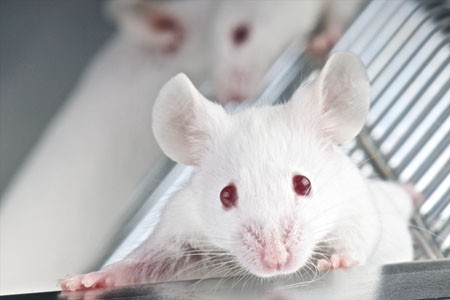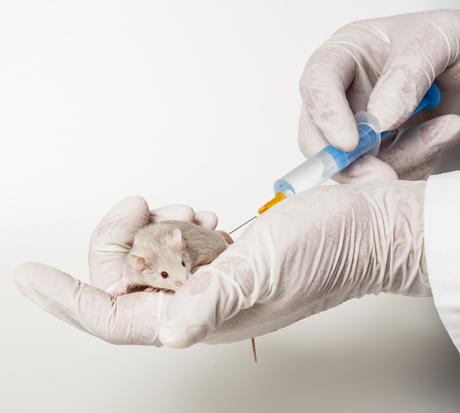IV Ketamine 2 or 3 Times Per Week Improves Depression
We have written many times before about intravenous ketamine as a fast-acting antidepressant treatment that can produce results within hours. Unfortunately, these quick results tend to fade within a few days. Current research is focused on possible ways of extending ketamine’s antidepressant effects.
A 2016 article by Jaskaran B. Singh and colleagues in the American Journal of Psychiatry reported that giving depressed patients infusions of ketamine (0.5mg/kg of body weight) twice or three times per week improved their depression compared to placebo over a period of up to 2 weeks.
Side effects included headache, anxiety, dissociation, nausea, and dizziness. The dissociation was temporary and improved with repeated dosing.
In Mice, Ketamine Prevents Stress From Turning Into Depression
Stress increases the risk of psychiatric illnesses such as major depression and post-traumatic stress disorder. Not everyone who experiences stress goes on to develop these illnesses, though. Researchers are currently trying to find out why, exploring treatments that might increase resilience and prevent mental illnesses.
Animal research is often used to study depression. Mice exposed to certain stressors behave in ways that resemble human depression—like giving up faster when they’re forced to tread water, or withdrawing from activities they once enjoyed, like eating sucrose. In a recent study by researcher Christine Denny and colleagues, mice were injected with either saline or ketamine, a rapid-acting antidepressant, and one week later they were exposed to triggers that typically produce a depressive response. Mice who received the saline injection still got depressed when, for example, they were repeatedly forced to confront a dominant mouse. But mice who received ketamine injections did better, maintaining their motivation and not showing signs of depressive behavior following the stress. The researchers concluded that ketamine may have a protective effect against stress.
Editor’s Note: These results are remarkable because ketamine’s effects are typically short-lived.
Intranasal Ketamine Produces Long-Lasting Antidepressant Effects
It has been known for years that ketamine, an anesthetic at higher doses, can quickly produce anti-depressant effects when delivered intravenously. However, these effects typically last only a few days. New research is exploring how to extend the antidepressant effects of ketamine.
Researcher Ella Daly and colleagues recently compared a form of ketamine called esketamine, this time delivered intranasally, to placebo in people with tough-to-treat depression that had resisted other treatments. Daly and colleagues randomized participants to receive one of three different doses of intranasal esketamine (28mg, 56mg, or 84mg) or placebo twice a week.
All of the doses of intranasal esketamine improved participants’ depression compared to placebo, with higher doses producing more sustained improvement. After the 2-week double-blind study, participants could choose to continue (or begin) taking esketamine for another nine weeks, tapering dosage slowly from twice a week to once every other week by the end. The participants were then monitored for another eight weeks. The intranasal esketamine doses they received led to sustained improvements in depression that lasted, in some cases, through the eight weeks following their final dose.
Side effects were not severe. Ketamine can produce dissociative sensations, but these tended to dissipate with two hours of administration.
Johnson and Johnson Pharmaceuticals funded this research, which was presented at a scientific meeting in 2015, and they plan to continue researching intranasal esketamine in the hopes of getting Food and Drug Administration approval for the drug.
Ketamine: Equal Efficacy When Given With Lithium Or Valproate
Studies of rodents with depression-like behaviors revealed that the combination of low (sub-therapeutic) doses of lithium and infusions of ketamine produced antidepressant-like effects. Researchers believed this might mean that in humans, lithium might have a unique effect potentiating the effects of ketamine.
In a small study by Mark J. Niciu presented at the 2015 meeting of the Society for Biological Psychiatry, patients with bipolar depression taking lithium or valproate mood stabilizers were given ketamine infusions or control infusions. In the 23 patients taking lithium and the 13 taking valproate, ketamine’s antidepressant effects were significantly better than placebo, but there was no difference between lithium and valproate with regard to these antidepressant effects. These preliminary data in a small number of subjects do not support the proposition that lithium augments the effects of ketamine in depression.
Ketamine Temporarily Reduces Suicidal Thoughts
Intravenous ketamine can bring about rapid improvement in depressive symptoms among people with treatment-resistant depression. Because of its rapid effects, which can appear after only two hours, ketamine is being investigated as a treatment for people with suicidal thoughts.
At the 2015 meeting of the Society of Biological Psychiatry, Laili Soleimani and colleagues presented a poster about their recent double blind, randomized, controlled pilot study of ketamine inpatients and outpatients who scored highly on a measure of suicidal ideation. The 24 participants were randomized to receive either a single intravenous infusion of ketamine (0.5mg/kg) or a single infusion of midazolam (0.045 mg/kg), which shares ketamine’s anxiety-reducing effects but does not have antidepressant effects. They reported suicidal thoughts at 24 hours post-infusion, 48 hours, 72 hours, and 7 days. At 48 hours, those who received ketamine reported significantly reduced suicidal ideation compared to those who received midazolam, but this effect was no longer significant at the 72-hour mark.
The findings show that ketamine can briefly reduce suicidal ideation, and that the treatment is safe and tolerable for patients. This pilot study paves the way for further study of ketamine to reduce suicidal thinking in people who are at high risk for suicidal behavior.
Ketamine Improves Sleep and Reduces Suicidal Thoughts in Certain Patients
Intravenous ketamine is known for its fast-acting antidepressant effects, which can appear within two hours of an infusion. Researchers are now investigating its use for the reduction of suicidal thoughts. In a study presented in a poster at the 2015 meeting of the Society of Biological Psychiatry, Jennifer L. Vande Voort and colleagues compared the sleep of patients whose suicidal thoughts decreased after a single ketamine infusion (0.5 mg/kg over 40 minutes) to those whose suicidal thoughts remained.
Study participants whose suicidal thoughts diminished after one infusion of ketamine had better sleep quality the following night, with fewer disruptions in sleep than among those who did not have an anti-suicidal response to ketamine. The participants who responded well to ketamine had sleep quality similar to that of healthy controls.
Vande Voort and colleagues hope that these new findings about ketamine’s effect on sleep may provide clues to the biological mechanism behind ketamine’s effect on suicidal ideation.
Bloomberg Covers Ketamine as a Depression Treatment
Over the years, we’ve tried to keep readers updated about ketamine‘s use as a fast-acting antidepressant. Bloomberg Business recently covered how the drug is being used by some to treat depression.
Meta-Analysis Shows Effectiveness of Ketamine for Bipolar and Unipolar Depression
Ketamine, an anesthetic sometimes used intravenously in the treatment of depression, can bring about rapid onset of antidepressant effects. A new meta-analysis by researcher Michael Bloch and colleagues presented at a recent conference showed that ketamine’s maximum antidepressant effects occur within one day of administration, and its effects remain significant (compared to control conditions) one week following infusion. Ketamine’s effects were diminished in patients taking other medications. There was a trend for better response in patients with bipolar disorder than with unipolar disorder.
Bloch and colleagues analyzed eight earlier studies including a total of 180 participants. In each study, ketamine had been compared to a control condition, either an infusion of saline solution or of midazolam, which mimics ketamine’s sensory effects but does not have antidepressant effects. The researchers are calling for more meta-analyses of ketamine studies to determine which patients respond best to ketamine and how to sustain ketamine’s effects.
Editor’s Note: In another poster presented at the same conference, James Murrough reported that patients with slower processing speed responded best to ketamine. Other findings have shown that those with a history of alcohol abuse and a common genetic variant of brain-derived neurotrophic factor (BDNF), the val-66-val allele of proBDNF, are more likely to respond to ketamine.
Lithium Extends Anti-Depressant Effects of Ketamine in Mice
While it can sometimes take weeks for the effects of antidepressant treatments to appear, intravenous ketamine can produce antidepressant effects in as little as two hours. However, ketamine’s effects fade after three to five days. New animal research by Chi-Tso Chiu et al. explores whether adding lithium to ketamine treatment can produce more sustained antidepressant effects.
Mice who are restrained by being placed in a tube for several hours (chronic restraint stress) exhibit a behavioral and neurochemical profile that resembles human depression. When Chiu and colleagues pretreated these stressed mice with sub-therapeutic doses of lithium (600 mg/L) in their drinking water for several weeks, a sub-therapeutic dose of ketamine (2.5 mg/kg of body weight) was enough to produce robust antidepressant effects in the mice, while neither drug alone was effective at these doses.
The combination of ketamine and lithium also restored the density of spines on the dendrites of neurons in the medial prefrontal cortex. Post-treatment with lithium (1200 mg/L) for several weeks was also successful in extending the effects of a single (50 mg/kg) ketamine injection.
Both lithium and ketamine affect the intracellular signaling pathway mTOR. Ketamine activates the pathway, increasing levels of synaptic proteins and dendritic spine density. It also increases brain-derived neurotrophic factor (BDNF) and the BDNF receptor TrkB. BDNF is important for learning and memory.
When lithium was added to the treatment of the mice with ketamine, the mTOR and BNDF pathways were further activated. Lithium also inhibits the receptor GSK-3, supporting ketamine’s rapid-acting antidepressant effects.
Ketamine treatment can produce oxidative stress, in which toxic free radicals can endanger cells, and the addition of low doses of lithium also completely prevented this neurochemical side effect.
Chiu and colleagues hope that the findings of this study in mice can eventually be applied to research in humans in the hopes of finding a clinical option that would sustain the rapid-onset antidepressant effects of ketamine for the long term.
Rapid-Onset Antidepressant Treatments
At the International College of Neuropsychopharmacology (CINP) World Congress of Neuropsychopharmacology in 2014, several presentations and posters discussed treatments that bring about rapid-onset antidepressant effects, including ketamine, isoflurane, sleep deprivation, and scopolamine.
Ketamine’s Effects
Multiple studies, now including more than 23 according to researcher William “Biff” Bunney, continue to show the rapid-onset antidepressant efficacy of intravenous ketamine, usually at doses of 0.5 mg/kg over 40 minutes. Response rates are usually in the range of 50–70%, and effects are seen within two hours and last several days to one week. Even more remarkable are the six studies (two double-blind) reporting rapid onset of antisuicidal effects, often within 40 minutes and lasting a week or more. These have used the same doses or lower doses of 0.1 to 0.2mg/kg over a shorter time period.
Attempts to sustain the initial antidepressant effects include repeated ketamine infusions every other day up to a total of six infusions, a regimen in which typically there is no loss of effectiveness. Researcher Ronald Duman is running a trial of co-treatment with ketamine and lithium, since both drugs block the effects of GSK-3, a kinase enzyme that regulates an array of cellular functions, and in animals the two drugs show additive antidepressant effects. In addition, lithium has been shown to extend the acute antidepressant effects of one night of sleep deprivation, which are otherwise reversed by a night of recovery sleep.
Ketamine’s effects are related to the neurotransmitter glutamate, for which there are several types of receptors, including NMDA and AMPA. Ketamine causes a large burst of glutamate presumably because it blocks NMDA glutamate receptors on inhibitory interneurons that use the neurotransmitter GABA, causing glutamatergic cells to lose their inhibitory input and fire faster. While ketamine blocks the effects of this glutamate release at NMDA receptors, actions at AMPA receptors are not blocked, and AMPA activity actually increases. This increases brain-derived neurotrophic factor (BDNF), which is also required for the antidepressant effects of ketamine. Ketamine also increases the effects of mTOR, a kinase enzyme that regulates cell growth and survival, and if these are blocked with the antibiotic rapamycin, antidepressant effects do not occur.
In animal studies, ketamine increases dendritic spine growth and rapidly reverses the effects of chronic mild unpredictable stressors on the spines (restoring their mature mushroom shape and increasing their numbers), effects that occur within two hours in association with its rapid effects on behaviors that resemble human depression.
About 50–70% of treatment-resistant depressed patients respond to ketamine. However, about one-third of the population has a common genetic variation of BDNF in which one or both valine amino acids that make up the typical val-66-val allele are replaced with methionine (producing val-66-met proBDNF or met-66-met proBDNF). The methionine variations result in the BDNF being transported less easily within the cell. Patients with these poorly functioning alleles of BDNF are less likely to get good antidepressant effects from treatment with ketamine.
Ketamine in Animal Studies
Researcher Pierre Blier reviewed the effects of ketamine on the neurotransmitters serotonin, norepinephrine, and dopamine. In rodents, a swim stress test is used to measure depression-like behavior. Researchers record how quickly the rodents give up trying to get out of water and begin to float instead. Blier found that ketamine’s effects on swim stress were dependent on all three neurotransmitters. For dopamine, ketamine’s effects were dependent on increases in the number of dopamine cells firing, not on the firing rate, and for norepinephrine, ketamine’s effects were dependent on increases in burst firing patterns. Each of these effects was dependent on glutamate activity at AMPA receptors. Given these effects, Blier believes that using ketamine as an adjunct to conventional antidepressants that tend to increase these neurotransmitters may add to its clinical effectiveness.
Important Anecdotal Clinical Notes
Blier reported having given about 300 ketamine infusions to 25 patients, finding that two-thirds of these patients responded, including one-third who recovered completely, while one-third did not respond to the treatment. Patients received an average of 12 infusions, not on a set schedule, but according to when they began to lose response to the last ketamine infusion. If a patient had only a partial response, Blier gave the next ketamine treatment at a faster rate of infusion and was able to achieve a better response. These clinical observations are among the first to show that more than six ketamine infusions may be effective and well tolerated. Read more










